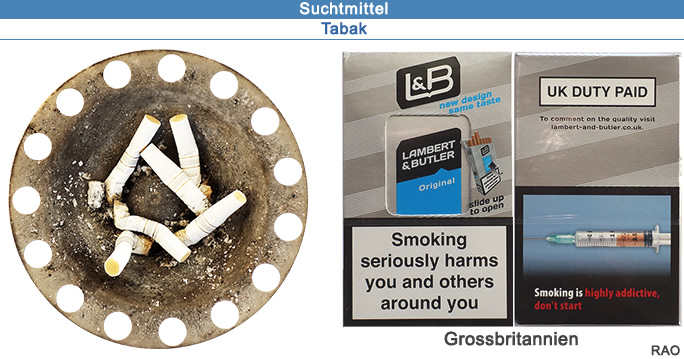 |
 |
Drogen
und Sucht |
|
|
Drogen und Sucht: Berichte
|
| WHO schlägt Alarm wegen den Umweltschäden der Tabakindustrie |
Tabak: Kohlendioxidausstoss und chemische Giftstoffe gefährden Klima und Umwelt
In ihrem Bericht "Tobacco: Poisoning our planet" zeigt die Weltgesundheitsorganisation WHO auf, dass die Tabakindustrie für rund ein Fünftel der jährlichen ausgestossen Kohlenstoffdioxidmenge verantwortlich ist. Die zivile Luftfahrt erzeugt jedes Jahr etwa die gleiche Menge an CO2.
Nach Angaben der WHO verursacht die Produktion und der Konsum von Tabakprodukten jedes Jahr den Tod von 8 Millionen Menschen, den Verlust von 600 Millionen Bäumen und 200'000 Hektaren Land. Die Tabakindustrie verbraucht jährlich 22 Milliarden Tonnen Wasser und erzeugt 84 Millionen Tonnen Kohlendioxid CO2, einem umweltschädlichen Treibhausgas.
Die Mehrheit der Tabakfelder befinden sich in Ländern mit eher bescheidenen Einkommensverhältnissen. Das Kulturland und das Wasser in diesen Ländern würde in diesen Ländern dringend für den Anbau von Lebensmittelpflanzen statt für Tabakpflanzen benötigt. Immer häufiger werden in diesen Region auch grosse Waldflächen für den Anbau von Tabakpflanzen gerodet.
Ungefähr 4,5 Billionen weggeworfene Zigarettenstummel mit ihren Filtern verunreinigen die Umwelt jedes Jahr. Tabakprodukte enthalten über 7'000 giftige chemischen Substanzen, welche sich in der Umwelt verbreiten können. Zigarettenfilter enthalten Mikroplastik. Die Zigarettenfilter sind weltweit der zweitgrösste Verursacher von Mikroplastikabfällen.
 |
| Text: RAOnline, Quelle:
WHO, 31. Mai 2022 |
| WHO raises alarm on tobacco industry environmental impact |
WHO has today revealed new information on the extent to which tobacco damages both the environment and human health, calling for steps to make the industry more accountable for the destruction it is causing.
Every year the tobacco industry costs the world more than 8 million human lives, 600 million trees, 200 000 hectares of land, 22 billion tonnes of water and 84 million tonnes of CO2.
The majority of tobacco is grown in low-and-middle.income countries, where water and farmland are often desperately needed to produce food for the region. Instead, they are being used to grow deadly tobacco plants, while more and more land is being cleared of forests.
The WHO report "Tobacco: Poisoning our planet" highlights that the industry's carbon footprint from production, processing and transporting tobacco is equivalent to one-fifth of the CO2 produced by the commercial airline industry each year, further contributing to global warming.
"Tobacco products are the most littered item on the planet, containing over 7000 toxic chemicals, which leech into our environment when discarded. Roughly 4.5 trillion cigarette filters pollute our oceans, rivers, city sidewalks, parks, soil and beaches every year," said Dr Ruediger Krech, Director of Health Promotion at WHO.
Products like cigarettes, smokeless tobacco and e.cigarettes also add to the build-up of plastic pollution. Cigarette filters contain microplastics and make up the second-highest form of plastic pollution worldwide.
Despite tobacco industry marketing, there is no evidence that filters have any proven health benefits. WHO calls on policy-makers to treat cigarette filters, as what they are, single use plastics, and consider banning cigarette filters to protect public health and the environment.
The costs of cleaning up littered tobacco products fall on taxpayers, rather than the industry creating the problem. Each year, this costs China roughly US$ 2.6 billion and India roughly US$ 766 million. The cost for Brazil and Germany comes in at over US$ 200 million (see table below for further estimates).
Countries like France and Spain and cities like San Francisco, California in the USA have taken a stand. Following the Polluter Pays Principle, they have successfully implemented "extended producer responsibility legislation" which makes the tobacco industry responsible for clearing up the pollution it creates.
WHO urges countries and cities to follow this example, as well as give support to tobacco farmers to switch to sustainablecrops, implement strong tobacco taxes (that could also include an environmental tax) and offer support services to help people quit tobacco.
Note to the editor: In the table below, we present estimates of tobacco product waste (TPW) attributable costs in one country from each of the WHO regions. These estimates are based on the "proportional estimation" approach, which starts with an estimate of the costs of total litter ("all product waste," or APW) for each country, and then applies an estimate of the proportion of all litter that is TPW (i.e., a TPW "weight").
For estimated APW costs ), we relied on publicly available literature and reports for as many of the six countries as possible. For Brazil, China, and India, we were not able to identify any sources. Thus, for those countries, we imputed APW costs by applying the average APW cost per capita of similar middle-income countries for which data were available. Once we had an APW cost for all countries, we applied the TPW proportion. The TPW proportion was based on the global average from the Ocean Conservancy's International Coastal Cleanup, weighted by the WHO smoking prevalence in each country (i.e., we assumed that countries with higher rates of smoking would have higher proportions of TPW). The final TPW cost estimate is the APW cost multiplied by the weighted TPW proportion.
 |
| Source:
WHO, 31 May 2022 |
nach
oben
|
Links
|
 |
 |
 |
Externe Links |
|















